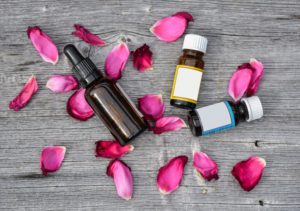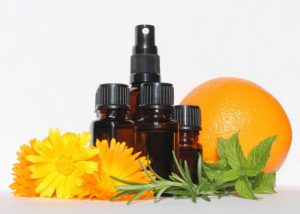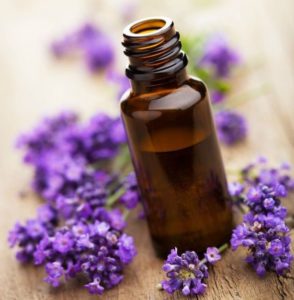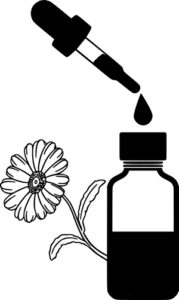
Whether you wish to create your own personal scent or just have fun experimenting with essential oils, the most important thing to remember is that there are no hard and fast rules for blending. When starting this process, it can feel a bit overwhelming but there are really just some basics to know and if you learn these blending tips then you will know how to blend essential oils together and become a pro at it. What’s better than making your own personal blend with scents that you love? I’ve had so much fun experimenting with blends once I had the general understanding of which oils blend well together.
The General Rules of Blending
- Florals blend well with spicy, citrusy and woodsy oils
- Woodsy oils generally blend well with all categories
- Spicy and oriental oils blend well with florals, oriental and citrus oils
- Minty oils blend well with citrus, woodsy, herbaceous and earthy oils
There are Top, Middle and Base Notes in blending:
- Oils that evaporate the quickest, usually within 1-2 hours, are called “Top Notes”
- Oils that evaporate within 2-4 hours are considered “Middle Notes”
- Oils that take the longest time to evaporate are referred to as “Base Notes”
When creating a new blend, start out small with a total number of drops of either 5, 10, 20 or 25 drops should be the most that you start with. Less oil is wasted this way in your blending experiments. Don’t forget you will need blending bottle(s).
Start off your blended experiments by creating blends that are made up in the following ratio (more or less)
- 30% of the oils are top notes
- 20% are middle notes
- 10% are base notes
I call this ratio the 3…2…1.
Essential Oil Blending Basics
Essential oils can be categorized into separate groups based on their aromas as noted below. Oils in the same category generally blend well together.
- Floral – Lavender, Rose, Jasmine
- Woodsy – Pine, Cedar and Sandalwood
- Earthy – Vetiver, Patchouli
- Herbaceous – Rosemary, Basil
- Minty – Peppermint, Spearmint
- Medicinal – Eucalyptus, Tea Tree
- Spicy – Clove, Cinnamon
- Oriental – Ginger, Patchouli
- Citrus – Orange, Lemon
Essential Oil Dilutions
Essential oils are very strong if you are using 100% pure grade (which is recommended) and should be diluted in a carrier oil or incorporated into a finished product such as lotion, aroma spray or massage oil. The oil content should only count for 1% to 2% of the total blend. Here’s an easy reference for how much essential oil to add to 1 oz of carrier oil or to a finished product. These dilutions for 1 oz can be easily multiplied for larger batches of finished product.
1% Dilution
- 1 oz = 30 ml = 600 drops of oil
- 1% of 600 drops is 6
- Add 6 drops of essential oil for 1 oz of carrier oil or finished product
2% Dilution
- 1 oz = 30 ml = 600 drops of oil
- 2% of 600 drops is 12
- Add 12 drops of essential oil for 1 oz of carrier oil or finished product

Carrier Oils And Their Qualities
I get a lot of questions about which carrier oils to use so I really want to get in to some detail here about oil uses and what may work best for your skin type. When you choose a carrier oil make sure it is 100% pure, cold pressed and unrefined.
Apricot Kernal Oil: This is a light oil and absorbs well. Rich in vitamins A, B and E which are great for skin rejuvenation. This is great if you have sensitive skin, excellent for the face, leaves skin feeling smooth and is a wonderful moisturizer.
Avocado Oil: This oil is rich in vitamins A, D and E. It is great for the face, absorbs well and helps cell regeneration which is very good for mature skin.
Jojoba Oil: This is a great oil for hair and skin problems. It’s good for all skin types and gives a nice healthy glow to skin. It absorbs very well. It’s great for muscular and joint pains and is very soothing for inflammatory skin conditions such as dermatitis, eczema and psoriasis.
Sweet Almond Oil: This is the most commonly used carrier oil. It is moisturizing and absorbs very well. It’s rich in vitamin D and great for all skin types.
Rosehip Oil: Rosehip oil is fabulous for the skin. It is great for cell regeneration, is anti-aging and good for PMS and menopause. (Oh, I love this. Should be called “Thank the Lord” oil) Did I say this is fabulous? Oh yes!
Coconut Oil: This is a widely used oil and perfect to moisturize the skin and is also great for the hair. It is very calming to the skin so great for skin conditions that are inflamed.
Grape Seed Oil: Is an astringent so this is good for toning and tightening the skin.
Wheat Germ Oil: This oil is super rich in vitamin E which makes it great for your skin to regenerate and give it a healthy glow.
Evening Primrose Oil: Well known for it’s calming properties on the skin. It is an excellent moisturizer and skin softener.
Note: A 1% dilution would be 1 tsp carrier oil with 1 drop essential oil . A 5% dilution would be 5 tsp carrier oil with 5 drops essential oil.

Essential Oil Shelf Life Guide
This shelf life guide can be used as a reference when making your blends. (Labeling your EO blend with the date it was made is recommended)
Degradation comes about from 3 main ways: oxygen, heat and light. For this reason, it is best to store your oils in the refrigerator. They will last twice as long. Some essential oils oxidize or evaporate faster than others. The EOs which have a lot of oxides have the shortest shelf life, which is around 1-2 years. EOs which contain a lot of phenols may last up to 3 years. The EOs that contain ketones, monoterpenols and or esters usually have a shelf life of 4-5 years. The EOs that contain lots of sesquiterpenes and sesquiterpenols can last up to 6 years.
Shelf Life:
1 year: Lemon, Orange, Mandarin
2 years: Frankincense, Lime, Tea Tree
3 years: Basil, Bergamot, Blue Tansy, Elemi, Fennel, Juniper Berry, Melissa, Oregano, Rosalina, Rosemary
4 years: Cardamon, Cinnamon Bark, Chamomile, Clary Sage, Geranium, Helichrysum, Lavender, Peppermint, Spearmint, Ylang Ylang
5 – 6 years: Copaiba, Ginger, Myrrh, Pepper, Rose, Valerian, Wintergreen
6 + years: Vetiver, Sandalwood, Patchouli, Cedarwood

Grow, Blend, Heal
From dilutions, to carrier oils, to the shelf life guide, this is a great reference tool on how to blend your essential oils together. It is my hope that you can use this as a guide when starting your blending process. It all starts from mother nature’s garden to blending our own personal scents to healing your mind and body. Need to relax? I would love to share a special relaxation blend recipe with you. This is an amazing blend for someone that is stressed and will help with aches and pains. It can help soothe muscles, relax your nerves and uplift your mood.
Relaxation Blend:
- 60 ml carrier oil (of your choice)
- 15 drops Lavender oil
- 5 drops Rosemary oil
- 5 drops Bergamot
Ready to start blending? Click here for 100% natural essential oils.
Did you enjoy this article? I would love to hear your thoughts or if you have any questions on how to blend essential oils together. Please let us know by leaving a comment below.
